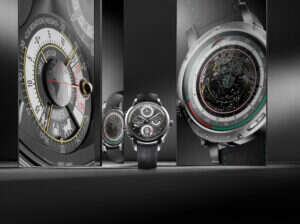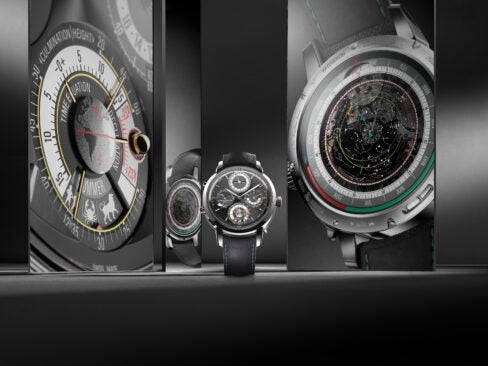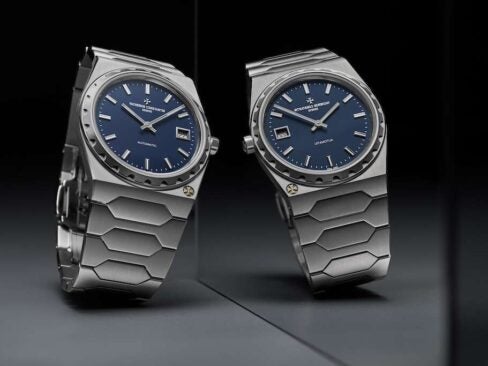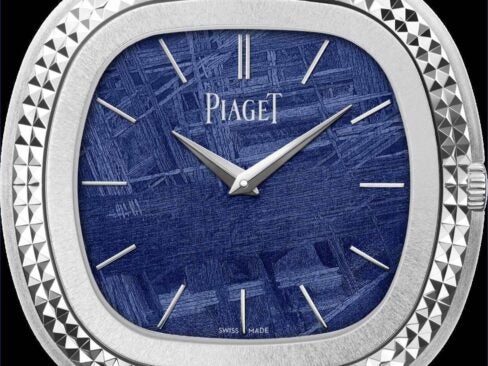By Zahra Al-Kateb
 The 14th Edition of the Grand Prix D’Horlogerie de Geneve is under way, and this year no less than 72 pre selected watches will be running to win the “Aiguille d’Or” Grand Prix.
The 14th Edition of the Grand Prix D’Horlogerie de Geneve is under way, and this year no less than 72 pre selected watches will be running to win the “Aiguille d’Or” Grand Prix.
With this year’s GPHG attracting record participation, all major watch groups are being represented, along with a number of independent companies.
Vote for your favorite amongst the following pre-selected watches and automatically participate in the drawing to win a Girard – Perregaux Vintage 1945 XXL Petite Seconde, worth $11372.29.
Here are the six finalists in the Mechanical Exception category. Next week we will be revealing the “Petite Aiguille” category.
 ANDREAS STREHLER, SAUTERELLE À LUNE PERPÉTUELLE
ANDREAS STREHLER, SAUTERELLE À LUNE PERPÉTUELLE
Designed and manufactured by Andreas Strehler in his workshop in Sirnach, the Sauterelle à Lune perpétuelle has the unique Remontoir d’égalité by Andreas Strehler and a perpetual display of the phase of the moon.
With only four components, Andreas Strehler achieves almost eternity. Only almost, because the Lune perpétuelle’s phase of the moon mechanism does require an occasional adjustment. To be quite precise, it requires an adjustment by ten minutes every 14’000 years or by one day every two million years. This adjustment is made through the crown and also works backwards.
The Sauterelle à Lune perpétuelle by Andreas Strehler is the most precise phase of the moon ever built, combined with a unique constant force mechanism.
Technically, the Lune perpétuelle is based on the Sauterelle, presented last year. Like the Sauterelle, also the Lune perpétuelle features Andreas Strehler’s unique Remontoir d’égalité, delivering a constant supply of energy to the escapement.
For the first time in a wristwatch, Andreas Strehler, offers a mechanical solution which eliminates nearly all technical and mechanical influences hampering the escapement. The constant and linear supply of energy to the balance is the ideal in watchmaking. It is the basis for precision. For the Sauterelle, Andreas Strehler has gone his very own way in realising this regulated supply of energy to achieve the most technically stable solution.
 HUBLOT, MP-05 LA FERRARI 50 DAYS POWER RESERVE
HUBLOT, MP-05 LA FERRARI 50 DAYS POWER RESERVE
50-day power reserve: A World Record power reserve for a hand-wound Tourbillon wristwatch.
Movement 100% designed, developed and produced by the Hublot Manufacture engineers and watchmakers
We are in the world of the exceptional. The MP-05 “LaFerrari” represents a very special series, entirely designed and developed by the Hublot Manufacture engineers and watchmakers in tribute to “LaFerrari”.
In a demonstration and testimony that lives up to the car, it has achieved a historic record with its 50-day power reserve. It is also the watch with the most watchmaking components created to date by Hublot (637).
The watch and the car: The MP-05 “LaFerrari” was developed – in technical and design terms – entirely in parallel with the car, alongside the Ferrari teams. They share a number of common points. Able to boast no fewer than 637 components for the movement, which is also equipped with a Tourbillon, as well as a power reserve of approximately 50 days thanks to its 11 barrels, arranged in a line just like a spinal column and interconnected so that they do not each discharge in turn but support each other, this watch is closer to being a concept watch.
The watch is finely wrought in terms of shape, featuring a complex shaped sapphire crystal clearly reminiscent of the car’s outline, as well as an open case-back, and is made from black PVD titanium. It is topped by a titanium and carbon insert in its centre, revealing the winding crown. The time-setting crown is positioned under the case. Both are completely integrated into the design, and therefore practically invisible.
The movement has an original display, featuring first off on the front vertical face the small seconds indicated by means of an aluminium cylinder fastened onto the suspended Tourbillon cage (significantly bigger than usual with a cage diameter of 14.50 mm, for even better appreciation of the mechanical parts).
The hour and minute are displayed to the right of the barrels, also indicated by means of one anodised black aluminium cylinder each. On their left is the cylinder indicating the power reserve. Reinforcing bars either side, made from anodised red aluminium, bring to mind Ferrari’s red signature.
A small detail, but one which makes reading the time easier; on each cylinder the size of the numerals has been maximised with white SuperLuminova™, to enhance the display for ease of reading. This is all rounded off by a rubber strap with a special folding buckle in black PVD titanium.
The desire for a truly exceptional watch has been extended to the design of the presentation case, made from schedoni leather and carbon fibre, containing the specific tools for winding the watch, and whose design was also inspired by the world of motoring. Limited edition of 50 numbered pieces.
 JAQUET DROZ, THE BIRD REPEATER
JAQUET DROZ, THE BIRD REPEATER
For many years, whether on the canvas where the painter brings his work into being or the dial where the sculptor applies his relief decoration, the brand’s workshops have paid homage to birds and brought them to life.
Today, Jaquet Droz adds a new dimension to mankind’s age-old dream of flying and pushes back the boundaries of Haute Horlogerie with The Bird Repeater. This exceptional timepiece, conceived by the craftsmen of the House, blends the history, know-how and imaginative power of Jaquet Droz in a way as precious as it is original.
In a stunning visual show, The Bird Repeater represents two Blue Tits, symbolic of Pierre Jaquet-Droz’s native Jura region, together over the nest containing their fledglings. In another nod to the origins of the Manufacture, the Saut du Doubs waterfall also figures on the dial of this new horological treasure. Fully animated by a mechanism of unequalled complexity, this three-dimensional picture truly comes to life. While one of the birds bobs to give a beakful of food to its offspring, the wings of its companion spread. An egg in the middle of the nest opens to reveal a chick, while the water of the stream flows in a continuous cascade.
The Bird Repeater is an authentic automaton, with a cam system inherited directly from the century of Enlightenment, and it calls upon the resources of all the decorative crafts. Jaquet Droz engravers and painters have worked together to produce the birds’ plumage, the perfectly balanced volumes and the finely detailed wisps of grass forming the nest. To achieve the realism of this scene no less than eight different animation mechanisms act in synchronism: the movement of the birds’ heads and wings, the movement of the fledglings, the hatching of the egg, the sparkle of the flowing water.
True to the brand’s extremely exacting philosophy, Jaquet Droz has given The Bird Repeater one of haute horlogerie’s most virtuoso complications: Minute Repetition. Simply pressing the pushbutton makes the watch strike the hours, quarters and minutes and sets the wonderful animated sequences in motion. The resonance and mellow tone of its cathedral gong, generated by two turns around the mechanism, are equaled only by the complexity of the system of chimes incorporated in the gold case, 47 mm in diameter and only 18.4 mm thick.
The Bird Repeater, made up of 508 separate components, has a 48-hour power reserve, and is limited of just 8 pieces. The outcome of two years of development, this new, dazzling masterpiece is the latest illustration, and doubtless the most extreme example of the uniqueness of the Jaquet Droz spirit: giving life, like no other, to the poetry of Time.
The Bird Repeater is already on view today, but the Manufacture is in the process of completing a piece that will be the crowning glory of its historic link with the world of birds when it is presented at Baselworld 2013. At La Chaux-de-Fonds, like the song of the blue tits and the music of the Saut du Doubs waterfall, the enchantment of Time will not soon fade away.
Legacy Machines are wondrous reinterpretations of significant horological inventions by the greatest watchmakers in history. So the contemporary look endowed by the otherworldly appearance of Legacy Machine No.2’s dual flying balances, suspended high above the dial from four gracefully arcing arms, may at first appear paradoxical. But make no mistake; LM2 is a timepiece tracing its lineage back over 250 years to three of the greatest watchmakers who ever lived: Abraham-Louis Breguet (1747– 1823), Ferdinand Berthoud (1727– 1807) and Antide Janvier (1751– 1835).
These horological legends of the 18th century are united not only by their inventive genius, but also by the fact that they have all constructed clocks and watches with two balances.
Oscillating on high, the exalted double balance wheels of LM2 were inspired by, and pay homage to, one of the rarest mechanisms in the history of watchmaking: the dual regulator. And rarer still, the average rates of Legacy Machine No.2’s dual regulators are transmitted by a differential to a single gear train, where the majority had two separate movements.
On display under a domed sapphire crystal cupola, the dial of Legacy Machine No. 2, which is actually the top plate of the exquisitely finished movement, is an object lesson in symmetrical simplicity. Top to bottom: the white stretched lacquer sub dial at 12 o’clock, with its blued gold hour and minute hands, is visually balanced by the large, raised differential at 6 o’clock. Left to right: the two flying balances and their escapements are identical mirror images, right down to the position of the stud holders pinning their balance springs.
While the levitated oscillating balance wheels of the binary regulators catch and hold the viewer’s gaze, it is the large planetary differential sitting proud of the dial that is the real heart of Legacy Machine No. 2. In an incredible feat of micro-engineering − and the sheer paucity of timepieces with multiple regulators connected via a differential attests to the enormous difficulty in creating such a complex high-precision mechanism − the differential has three roles: 1. Transferring power to each of the regulators; 2. Receiving the individual timing rates from each balance; and 3. Transmitting the average rate of the two regulators to the gear train, where it finally manifests itself as the displayed time.
The movement of Legacy Machine No. 2 was developed to MB&F’s specifications by award-winning watchmaker Jean-François Mojon (Best Watchmaker at the 2010 Grand Prix d’Horlogerie de Genève) and his team at Chronode. Acclaimed independent watchmaker Kari Voutilainen ensured that the movement’s aesthetic style was consistent with high-quality traditional timepieces of the 19th century and for specifying the superlative hand-finishing.
Immaculate Geneva waves, gold chatons, mirror-polished bevels and bridges designed with deliberate internal bevelled angles (which cannot be finished by machine) showcase the movement’s peerless fine finishing. Consistent with MB&F’s spirit of transparency, the names of the two men responsible for the movement are hand engraved on the back.
Two and a half centuries after three of the world’s greatest watchmakers put two balance wheels into their movements, MB&F celebrates their pioneering works by creating LM2, a timepiece with two balances hovering outside the movement.
Legacy Machine No.2 is available in 18k red gold, 18k white gold and a limited edition of 18 pieces in platinum 950 that features a striking sky-blue dial.
 TAG HEUER, MONACO V4 TOURBILLON
TAG HEUER, MONACO V4 TOURBILLON
In 2004, tag heuer changed the course of watchmaking by unveiling the monaco v4 concept watch, the world’s first watch with patented belt drives, linear mass and ball bearings.
The v4 name derived from the v-shaped platinum main plate on which the movement’s four barrels are mounted. this concept watch represented nothing short of a complete rewriting of the fundamental principles of mechanical watchmaking, housed inside another revolution, the audacious square-faced monaco.
In 2014, building on its top-secret development of transmission belts no thicker than a single hair, tag heuer takes its avant-garde creation to the next level—juxtaposing its patented belt technology with one of the most emblematic complication of watchmaking—the tourbillon.
By far the most intricate and iconic complication of haute horlogerie, a tourbillon is a mechanical system for regulating the speed at which a watch beats. traditionally, it overcomes the effects of gravity by placing the balance wheel and escapement inside a rotating cage.
The monaco v4 tourbillon brings this complication further, by using, in a world first, a micro-belt to drive the tourbillon. thanks to the belt driving the tourbillon, its rotation is absolutely fluid.
The EMC allows you to obtain a reliable and accurate piece of data on your timepiece at the touch of a button – information that until now has been the preserve of professional watchmakers. Using this information, you can fine-tune one of the most exciting, most jubilant mechanisms invented – the mechanical watch – all by yourself”. Felix Baumgartner
EMC (Electro Mechanical Control) is the world’s first precision mechanical watch wich the timing can be monitored and adjusted by the user to suit their lifestyle. EMC is a fully 100% mechanical watch and fully interactive. EMC features a deconstructed dial with 4 separate indications : (from top left) a precision indicator; seconds dial; hour and minutes; power reserve. Turning EMC over reveals the in-house movement with integrated circuit board.












